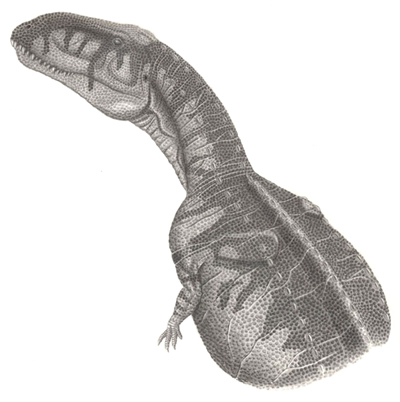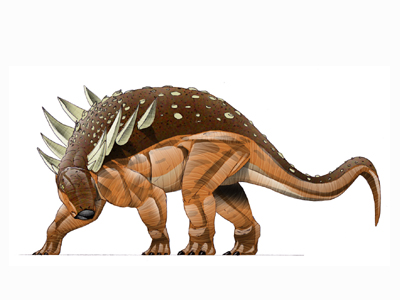Glossary AAC - ACR
Homepage > Glossary Pages - Glossary A
AACHENOSAURUS
Aachenosaurus is a fossil that was originally thought to be jaw fragments
from a duckbilled dinosaur (a hadrosaur), but the fossil turned out to
be petrified wood. Aachenosaurus was named by the scientist Abbey G. Smets
in 1888 (the type species was called A. multidens). The fossil's name
means "Aachen lizard," named for the Aachenian deposits of Moresnet
(which was a territory in Belgium) where the fossils were found.
ABAVORNIS
Abavornis (which means ""great-great-grandfather bird")
was a primitive bird that lived during the late Cretaceous period, about
85 million years ago. Fossils were found in the Bissekty Formation, Uzbekistan.
The type species is A. bonaparti. Abavornis was named by Panteleev in
1998.
 ABELISAURUS
ABELISAURUS
(pronounced ay-bel-uh-SAWR-us) Abelisaurus (meaning "Abel's lizard")
was a primitive theropod (a bipedal, meat-eating dinosaur) that was roughly
21 to 26 feet (6.5 to 7.9 m) long, weighing roughly 1500 kg. It lived
during the late Cretaceous period, 75-70 million years ago, in what is
now Patagonia, Argentina. It is known from a 35 inch (90 cm) long incomplete
skull named in honor of Roberto Abel (director of the Argentinian Museum
of Natural Science) and was named by paleontologists J. F. Bonaparte and
F. E. Novas in 1985. The type species is A. comahuensis.
ABRICTOSAURUS
(pronounced uh-BRICK-tuh-SAWR-us) Abrictosaurus (meaning "awake lizard")
was a heterodontosaurid (an ornithischian), a bipedal, plant-eating, long-tailed
dinosaur that was roughly 4.6 feet (1.2 m) long and weighed about 43 kg.
It had high-crowned teeth and lived during the early Jurassic period.
Unlike other heterodontosaurids, it lacked canine-like teeth on its lower
jaw. It is known from a skeleton and skull found in Lesotho, S. Africa
and was named by paleontologist J. A. Hopson in 1975.
ABROSAURUS
(pronounced AB-roh-SAWR-us) Abrosaurus (meaning "delicate or gentle
[skull] lizard") was a sauropod, a long-necked, plant-eating dinosaur.
It had a bulky body, column-like legs, and a small head with a nasal crest;
the nostrils were almost above the eyes. It lived during the early Cretaceous
period. Abrosaurus was named by paleontologist Ou in 1986. It is known
from fossils found in China. The type species is A. dongpoi. Very little
is known about this dinosaur.
ABSOLUTE AGE DATING
Absolute age dating seeks to determine the exact time that an organism
lived (or another event occurred). Compare with relative age dating.
ACANTHODIAN
Acanthodians were the earliest jawed vertebrates. These early fish (Class
acanthodii) lived from the Ordovician to the Carboniferous period. Although
most Acanthodians were small, averaging roughly 5-6 inches (13-15 cm)
long, some were much larger (for example, the genus Xylacanthus, known
from its huge jaws, is thought to have been perhaps 3 feet (1 m) long).
Some Acanthodians may have been primitive shark-like fish.
 ACANTHOPHOLIS
ACANTHOPHOLIS
(pronounced uh-CAN-thuh-FOE-lis) Acanthopholis (meaning "spiny scales
or scutes") was an armored, quadrupedal, plant-eating Ankylosaur
dinosaur from the early Cretaceous period (115 million-91 million years
ago). Its armor was rows of oval plates set into its skin, plus it had
9 inch (24 cm) spikes jutting out of its neck and shoulder area along
the spine. It was about 15 feet long (4 m) and weighed roughly 380 kg.
The type species is A. horridus (but Acanthopholis is a nomen dubium -
a dubious species).
ACANTHOSTEGA
Acanthostega (which means "spine plate") was an early tetrapod
that lived during the Devonian period (roughly 360 million years ago).
This aquatic animal was about 60 cm (2 ft) long (includign its long tail).
Its front limbs (and perhaps the rear limbs also) had 8 digits; it had
internal gills and lungs. Protective oval-shaped scutes protected its
belly. Fossils of this river-dweller have been found in East Greenland.
The type species is Acanthostega gunneri, found in 1933 and named in 1952
by Erik Jarvik. Additional specimens were found in 1970 (again in East
Greenland) by Jennie Clack and Per Ahlberg.
ACETABULUM
The acetabulum is the hip socket.
ACHELOUSAURUS
(pronounced ah-key-LOH-uh-SAWR-us) Achelousaurus, aka Achelosaurus (meaning
"Achelous' [a river god who lost his horns] lizard") was a Ceratopsid
dinosaur from the late Cretaceous period. This hornless, frilled, quadrupedal
plant-eater was about 20 ft (6 m) long. It had a nasal boss (a large,
rounded knob of bone) on its snout and had two long spikes on the rear
of its frill. Achelosaurus seems to be an intermediate between Einiosaurus
(which had a similar frill) and Pachyrhinosaurus (which had a similar
nasal boss). A partial skeleton was found in Montana, USA. The type species
is A. horneri. Achelousaurus was named by Sampson in 1995.
ACID RAIN
Acid rain is polluted and harmful to the environment. Acid rain has a
low pH. Acid rain may have been a component of the K-T extinction.
ACROCANTHOSAURUS
Acrocanthosaurus is known from incomplete skeletons and teeth. This large
carnivorous dinosaur walked on two long, powerful legs. Acrocanthosaurus
is famous for the tall spines on its back, and tail. The spines on some
large individuals were as much as 2 feet (60 centimeters) tall, which
gave this dinosaur a powerful looking profile. The tall vertebral spines
on the neck, back and tail, served as attachment points for muscles. And
may have been useful in grabbing, holding, or dismembering its prey.